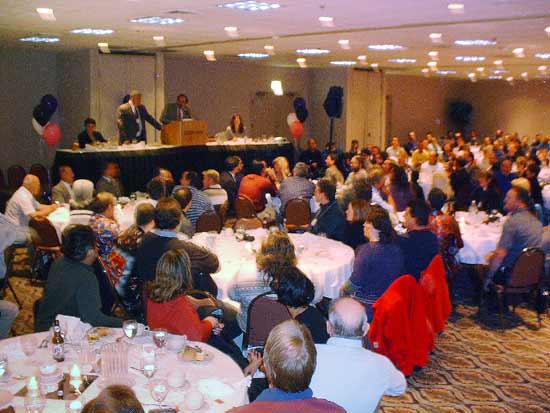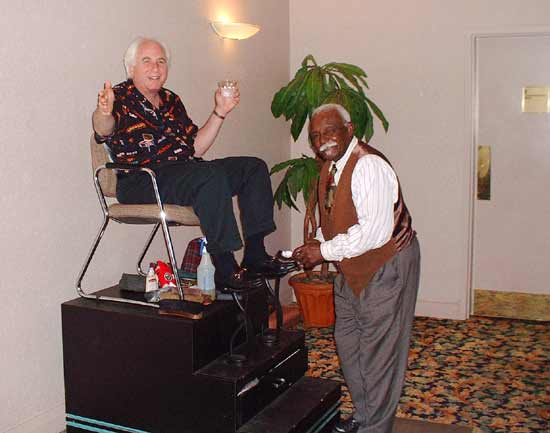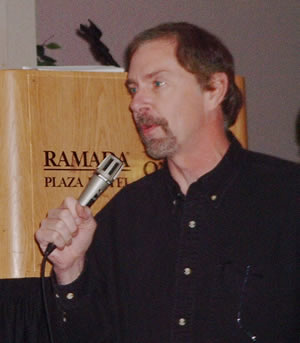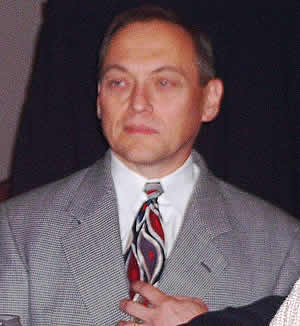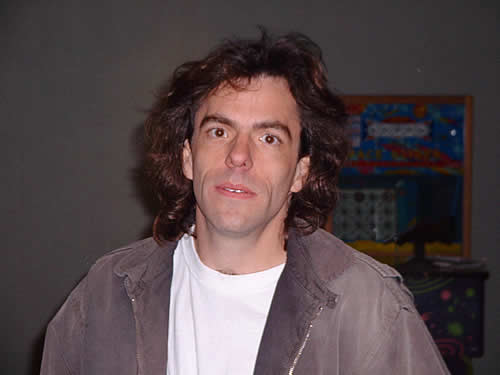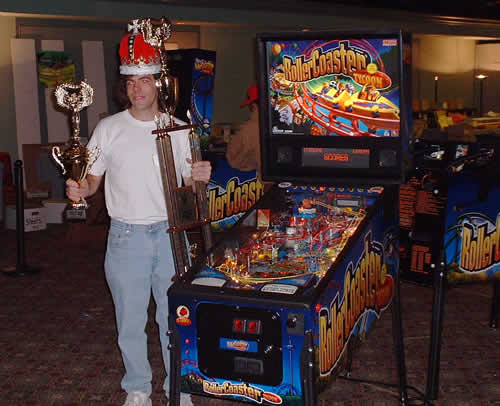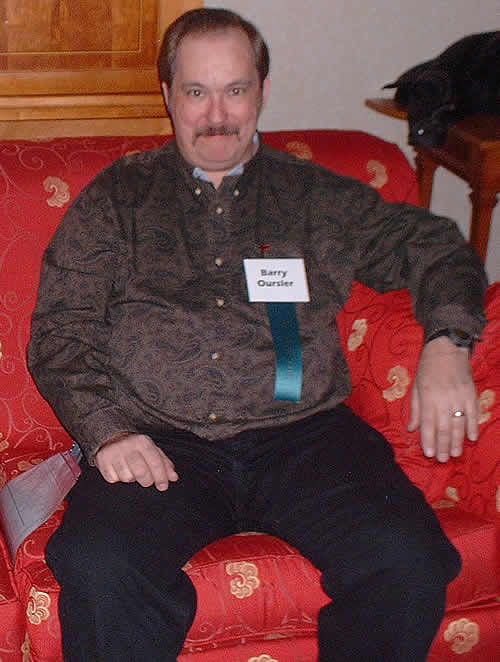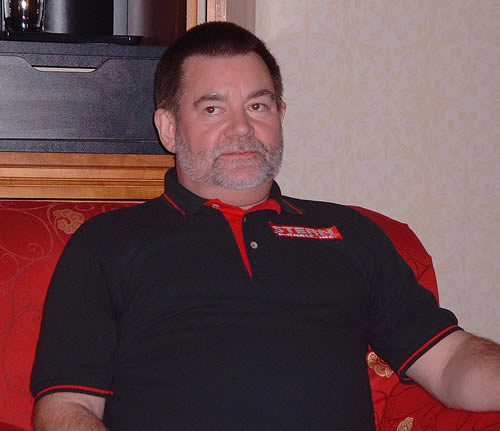
PINBALL
EXPO 2002
PART FOUR:
"IT ALL STARTED WITH BAGATELLE..."
|
26th November 2002 In part four, the final segment of this report from Pinball Expo we'll be covering the banquet, the tournament and the fireside chats. Quite a lot to report so for the last time, let's get on with it. Saturday
Evening Arrive late and you're in no-man's land for the rest of the night. Certain tables are pre-booked for Stern and PLD but there is a compromise to be made - do you want to be near the food, or the entertainment? Obviously for this intrepid reporter to be able to bring you the best pictures and reports there was only one choice. Sadly, all the seats by the food were taken, so I had to sit smack in the middle of the hall.
7.30pm: The annual charity fund raiser saw various items selling for prices ranging between very reasonable and ludicrous, but it seems the spirit of the event had overtaken everyone and nobody minded paying well in excess for a good cause. For reasons unexplained I came away from this with two sets of plastics for an X-Files game. It just seemed like a good idea at the time. I blame the Miller Genuine Draft. In fact everyone got in the spirit and one of the items auctioned was a shoeshine from the hotel's resident expert. Guess who won that particular item.
So with the preamble out of the way it was time for the banquet. Now, this has always been something of a misnomer in my opinion, since the food was neither plentiful nor of an especially high quality. This year one of those complaints was addressed with an all-you-can-eat buffet replacing the set meal. OK, the food was nothing special but you could choose the best bits. You had to be quick, though, as the food was soon cleared away. The main entertainment was the familiar Pat Lawlor Show and familiar was the best way to describe it. I got the feeling that we'd been here before - many times - and there was no spark to get the crowd excited. Pat started by reading a letter he received from show organiser Rob Berk inviting him to speak, reminding him that he needed to buy a ticket if he wanted to attend the banquet! I got the impression that this was indicative of his feelings about Expo and perhaps wasn't truly enjoying it. Just a feeling.
A question and answer session followed and I asked him if he would be making another game for Stern and he confirmed that he would indeed. However, even this answer and the attendant round applause revealed a certain boredom and predictability for Pat. Under the clapping you could hear him say "Yeah, yeah, yeah, applause, applause, applause", almost contemptuously. Hmmm. Perhaps it had been a long day. Another point to come from the Q+As was how he removed the final "S" target from the STEPS targets in Funhouse. He did this because Mark Ritchie, after playing some games said it kept getting in the way of his shots. So with 15 sample games made they removed it to leave just S-T-E-P. In between each question Pat referred to a series of supposed rec.games.pinball postings and made fun of the mentality behind them. I say "supposed" because I noted down the message headers and couldn't find any of them on Google's archive. Still, they were funny anyway even if they were totally concocted. Regarding the Rollercoaster Tycoon troll doll, he defended the doll's inclusion saying it appealed to the most people and he wanted something which looked like the little people running around in the PC game. He put the Dunk The Dummy mode in the game as a tribute to Barry Ousler - designer of the Comet series of game which included a Dunk The Dummy feature - and his favourite toy in one of his games is the shaker motor in Earthshaker. Returning to the present time, he restated the point made before by Gary Stern about how many pinball players on location are essentially drunk in bars. I found this a bit worrying. Are Stern really designing games for drunks? A few immediate themes came to mind but it certainly explains the number of toilets appearing in games, and probably the state of the playfield glass immediately above them. Putting any toys on a playfield has a price implication and Pat talked about this and on a similar theme, why wide-bodied games were unlikely to make a reappearance anytime soon. After that, things kind of ran out of time and steam, so the show came to a close. Perhaps familiarity does indeed breed contempt but for the first time ever I left The Pat Lawlor Show feeling disappointed. Rob Berk then stepped up to the microphone to announce two new entrants to the Pinball Hall of Fame - Christian Marche, the prolific artist who worked on over 140 games between 1961 and 1975 for Williams, Bally and Chicago Coin - and game designer Jim Patla.
Friday,
Saturday & Sunday: The format for the tournament was the same as in previous years - you competed to be one of the top 16 scores on the competition game - this year it was Rollercoaster Tycoon. From those top
16 scores, the top 8 became the "A Division" and the bottom
8 the They were:
Both divisions then had a series of head-to-head matches to reduce those 8 to 4 and then to 2 for the finals. The winner of the A Division was crowned Pinball Wizard. In the women's competition the top 8 scores qualified for the finals which worked in the same way but with only one division.
There were also competitions for those working for, or previously working for pinball manufacturers, youths, seniors and tots. These were the results for those divisions:
In the main tournament, the 'A' division was won by Lyman Sheats who beat Neil Shatz in a closely fought final.
Paul Madison finished in third place and Josh Sharpe fourth. In the 'B' Division the final was between Jim Belsito and Jason Werdrick, with Jim triumphing. Sean Grant won third place and Andy Rosa in fourth. In the Women's Division the final was between Heidi Conlan and Judy Crooks and Judy came out ahead to win. Tina Curtis was third and Janet Hardin fourth. The tournament finished with Lyman being awarded his prize (he's standing next to it) and made to wear a silly hat as punishemnt for being too good.
Thursday
evening: The fireside chats are one of the best features of Pinball Expo. They give everyone the chance to meet, hear and question some of the great names from the pinball world in a less formal setting than the seminars.
There were two fireside chats this year and the first of them was with game designer Barry Oursler the man who designed or co-designed Phoenix, Time Warp, Gorgar, Laser Ball, Scorpion, Jungle Lord, Solar Fire, Barracora, Cosmic Gunfight, Defender, Rat Race, Time Fantasy, Joust, Star Light, Space Shuttle, Comet, Grand Lizard, Pin*bot, Fire!, Fire! Champagne Edition, Space Station, Cyclone, Jokerz!, Police Force, Bad Cats, Harley Davidson, Hurricane, Doctor Who, Bram Stoker's Dracula, Popeye Saves the Earth, Dirty Harry, Who?dunnit, Jack*Bot, and Junk Yard. Presenting the chat was Gary Flower who kept the questions flowing while amongst the assembled crowd were fellow designers Steve and Mark Ritchie and Steve Kordek, who chipped in with their memories and comments to add to Barry's. Barry is a genial chap who appeared a bit startled at all these geeky pinball fanatics who had come along to hear what he had to say about his time in the business. He was quite prepared to accept the brickbats as well as the bouquets, making fun of some of his games along with some of those he has worked with over the years. Barry is perhaps best know as the man who designed the space shuttle game - the game widely credited with saving Williams Pinball from the invasion of video games. He described the gloom at the Williams factory as the production runs of successive games fell and fell from many thousands to a few hundred. Space Shuttle came out and changed all that spearheading the pinball fight back. Look at the figures - Barry's three games before Space shuttle and their production run, courtesy of the Internet Pinball Database: Time Fantasy - 608, Joust - 402 and Star Light - 100. After Space Shuttle: Comet - 8100, Grand Lizard - 2750 and Pinbot - 12001.
Police Force was originally going to be based on the Batman theme, but Williams failed to secure the licence for the Warner Bros film (it went to Data East). The police car on the left of the playfield was to be the Batmobile. Dracula was also not originally based on that theme but was supposed to be Alien 3. The Comet game was modelled
on the Riverview theme park in Chicago and was to be called by that
name, however it was (correctly) felt that nobody outside the Chicago
area would know of the attraction, and so the name was change to Comet
- then name of one of Riverview's roller coasters.
Friday
evening: This, for me, was probably the highlight of the show - the chance to hear from one of my favourite designers for the first time. While I love his Getaway design (and own one), I was particularly interested to hear about how he left Williams and why he's back designing for Stern. As with Thursday's fireside chat, Gary Flower introduced Steve, asked questions and relayed those from the audience. This latter was necessary as Steve has a disease that attacks the inner ear making it hard for him to hear. Once again, the guest was joined in the audience by various pinball luminaries to help out with the answers and join in the fun.
Steve started by saying he was "totally happy to be back in Chicago making pinball machines". Although he wouldn't expand on the game he is designing for Stern he did say it was going to be simpler than his previous games with more obvious rules and clearer shot cues for bar locations. He is working with Dwight Sullivan and Chris Granner, which was great news for me since Steve and Dwight worked on Getaway and I'm usually a great fan on Chris's music skills (though I'm not that impressed with Rollercoaster Tycoon, but then perfection is a tough act to maintain). After that, Steve went through all the games he designed. He started at Atari in California where he designed Airborne Avenger, which he now considers "a pile of junk". After that came Superman. He worked on that game for 17-18 months but he knew that he'd have to move to Chicago if he wanted to get anywhere in the pinball industry. So in 1978 he left Atari and joined Williams to design Flash - the first game with continuous sound throughout the game. It went on to sell almost 20,000 units. His next game was Stellar Wars, a wide-body game. Bally wanted a wide-bodied game, but Steve is unconvinced about them. "Wide bodies are too wide to be playable", he said, adding that he'd rather lengthen the playfield than widen it. He added that Stellar Wars was a frustrating game and he threw away his original design and started again. Firepower came next, "a breakthrough game" according to Steve. Sound and software was by Eugene Jarvis. "Working with Eugene was one of the greatest times of my life" he said. The game was the first to have dancing display animations and the first with an equalised multiball (one where each player has the same chance to start multiball regardless of whether previous players had locked balls or not). Steve said he thoroughly enjoyed making the game. Then came Black Knight - his first collaboration with Larry DeMar. A very expensive game to make, he had to fight Williams hard for the money but he did enjoy making it. Lots of people had talked about designing a two-layer game but Steve actually did it. After Black Knight Steve wanted to go and work on video games as that was the booming area of amusement games but his bosses at Williams weren't prepare to let him move away from the pinball division. So he made Hyperball - a video game made into a pinball game. At this time he moved back to California to start a video game company. It wasn't a success, but at the time lots of companies were losing money on video game as the market had saturated. So he came back to Chicago and pinball. High Speed was his first game upon his return - based on the true story of Steve's chase with the police. He gave up the chase and was charged with reckless driving and received a fine. He described High Speed as "another landmark game". He was working again with Larry Demar who was fighting hard to be allowed to use alphanumeric displays in the game. It was also Larry's Firebird that provided the car sounds. After designing everything they played the game together and realised that it just didn't work - so they junked the design and started again from scratch. Next after High Speed was F14 Tomcat. "If one light on the top was good, 3 must have been bitchin'" he said. Steve also wrote some of the music used in the game. Black Knight 2000 followed. Steve likes adversarial games and didn't see this one so much a sequel to, but more of an updating of the original Black Knight game. Like so many before, this had a problematic development but ultimately he enjoyed designing it. More problems followed with Rollergames when the TV show on which the game was, was cancelled before Williams could start production. The result was a somewhat demoralised team with Steve describing it as "not one of the best ones I ever did". Despite that, the game has is generally well thought of and has the memorable "Don't flip! FLIP!" sequence. Then came Terminator 2 when Steve worked with Dwight Sullivan again. Steve recalled meeting James Cameron (Director) and Stan Winston (Special make-up and effects) in Hollywood and how he learned a lot about dealing with licences which was to become valuable in his latter games. This is one of Steve's favourite games. "It all came together on T2" he said, especially the long loops and flowing shots. His only criticism of the game is the multiball sequence that he didn't think worked that well. Taking a brief diversion, Steve singled out Rollercoaster Tycoon as a good game, saying he thought it was Pat Lawlor's best game to date. Back to his own games and Steve moved on to High Speed 2 - the Getaway. This one he did think was a sequel to the original but had little more to add. Perhaps his most famous game is Star Trek - The Next Generation and again it was "incredible fun to do". Steve was part of the team that went to talk with Paramount to try to secure the licence. He went on the set and ate lunch with the cast. There were some negotiations with Paramount about the use of guns in the game and the conflict with the prime directive. Steve needed the speech of all the major characters from the series, which they got but Jonathan Frakes fooled around so much during recording that they could hardly use much from him. Patrick Stewart, on the other hand, really got into the project, correcting some of the speech and suggesting other ideas. This was true back at Williams with numerous contributions of ideas from many other employees. In the end, over 500 speech calls were included in the game and it was a wide-bodied game simply because the number of toys required it. In retrospect he thinks perhaps they went too far with the complexity of the game. Finally (for Williams), Steve designed No Fear. He has enjoyed motor cross for a long time and so wanted to do the license. Another adversarial game, this time against the skull. Steve described how, around this time, he and his colleagues were starting to get depressed at Williams as the number of games sold fell, and he could never see the company selling as many games as it did with ST-TNG. The atmosphere at Williams deteriorated. He saw the signs pointing to the end of pinball so the got the company to allow him to transfer to their sister company Atari where he developed the California Speed racing game. Although the product was successful he says he was never welcome there from the first day. Ultimately he was made redundant and slipped into depression. Gary Stern called him and asked about making a pinball for Stern and he jumped at the chance. He says Stern is a fun place to work, like the best days of Williams. He now only owns four pinball games - a Terminator 2 and a Star Trek TNG are at a friend's house, a Black Knight 2000 at his son's and he has a Stern Playboy. Finally, he spoke briefly again about his next game: "I'm going to do everything I want to do" he said.
After a rocky patch a couple of years ago, the resurgence of Stern Pinball and the steady expansion at Illinois Pinball has put Pinball Expo back at the top of the list of pinball shows. The proximity to the heart of the game means you can expect to find numerous pinball personalities wandering around the show and ensures a high quality of guest speakers. You may find one or two of them at other shows but not this many. So, the people are one point in the show's favour. Another is the number of parts suppliers. With 17 different vendors in the halls you are bound to find a good number of spares if you own any games (though you would be well advised to contact the sellers beforehand if you want any highly specialised parts). The Internet has made the availability of parts much easier but here you can actually see the goods and save on shipping costs too. Plus there are the special offers just for the show. But no show is without its downside. In truth, Pinball Expo could be a day shorter. Sunday is really all about the tournament and Thursday is mainly the factory tour. There are also some quiet moments in the schedule and while that is OK if you've got a car, but there's not much near the hotel to visit. So it should be possible to juggle the events around to make a killer schedule over three days. As described above, The Pat Lawlor Show lacked a certain spark and had a feeling of routine to it. Similarly, you can predict with 90% accuracy the names of those to be honoured in the banquet. Not that many of these don't deserve the plaudits but it's pretty much the same year in, year out. The final grip has to be familiar one - the number of games either switched off or not on free play. If the hall is to be open all night - as it is on Friday and Saturday nights - then you should be able to play those games that were busy all day, not find them depowered. Those are the minus points, but we must put them in context. We're getting towards the end of four fairly length articles full of great reasons to visit the show. The predominant feeling when
walking away from the show is one of optimism. Pinball seems a bit more
comfortable in its reduced size and now looks towards growth as opposed
to finding a way to halt the slide.
© Pinball News 2002 |
